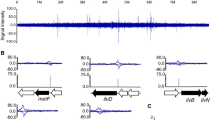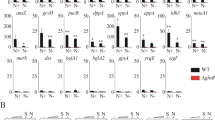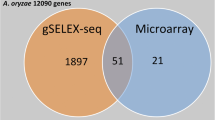Armenta RE, Valentine MC. Single-cell oils as a source of omega-3 fatty a ci-ds: an overview of recent advances. J Am Oil Chem Soc. 2013;90:167–82.
Article
CAS
Google Scholar
Raghukumar S. Ecology of the marine protists, the labyrinthulomycetes (thraustochytrids and labyrinthulids). Eur J Protistol. 2002;38(2):127–45.
Article
Google Scholar
Morabito C, Bournaud C, Maës C, Schuler M, AieseCigliano R, Dellero Y, et al. The lipid metabolism in thraustochytrids. Prog Lipid Res. 2019;76:101007.
Article
PubMed
CAS
Google Scholar
Raghukumar S, Damare VS. Increasing evidence for the important role of La-byrinthulomycetes in marine ecosystems. Bot. 2011;54(1):3–11.
Article
Google Scholar
Wang ZM, Yu C, Lu SH, **ao M, Zhou Q, Li XY. Protective effect of docosahexaenoic acid and eicosapntemacnioc acid on cardiovascular disease. China Food Additives. 2014;15(9):164–70.
Google Scholar
Cong M, Song C, Zou B, Deng Y, Li S, Liu X, et al. Impact of glutamine, eicosapnt-emacnioc acid, branched-chain amino acid supplements on nutritional status and treatment co-mpliance of esophageal cancer patients on concurrent chemoradiotherapy and gastric cancer patients on chemotherapy. Zhonghua Yi Xue Za Zhi. 2015;95(10):766–9.
PubMed
CAS
Google Scholar
Yang G, Li C, Guilini K, Peng Q, Wang Y, Zhang Y, et al. Feeding strategies of four dominant copepod species in Prydz Bay, Antarctica: Insights from a combined fatty acid biomarker and stable isotopic approach. Deep-Sea Res PT. 2016;I(114):55–63.
Article
Google Scholar
Anderson OR, Cavalier-smith T. Ultrastructure of diplophrys parva, a new small freshwater species, and a revised analysis of labyrinthulea (Heterokonta). Acta Protozool. 2012;51(4):291–304.
Google Scholar
Alberto A. Species concepts and definitions: Reproductive isolation as a tool to reveal species boundaries. Int J Plant Reprod Biol. 2010;2:114–26.
Google Scholar
Li Y, Chen L, Chen W, Zhu J, Chen Y, et al. Transcriptomic analysis of the metabolic regulatory mechanism of Schizochytrium limacinum B4D1 using sodium acetate to produce DHA. BioChem Eng J. 2023;197:108963.
Article
CAS
Google Scholar
Oliver L, Fernández-de-Castro L, Dietrich T, Villaran MC, Barrio RJ. Production of docosahexaenoic acid and odd-chain fatty acids by microalgae schizochytrium limacinum grown on waste-derived volatile fatty acids. Appl Sci. 2022;12(8):3976.
Article
CAS
Google Scholar
Liang L, Zheng X, Fan W, Chen D, Huang Z, Peng J, et al. Genome and transcriptome analyses provide insight into the omega-3 long-chain polyunsaturated fatty acids biosynthesis of Schizochytrium limacinum SR21. Front Microbiol. 2020;11:687.
Article
PubMed
PubMed Central
Google Scholar
Chen C, Zhang K, Khurshid M, Li J, He M, Georgiev MI, et al. MYB transc-ription repressors regulate plant secondary metabolism. Crit Rev Plant Sci. 2019;38(3):159–70.
Article
CAS
Google Scholar
Zhang Y, Cao G, Qu LJ, Gu H. Involvement of an R2R3-MYB transcription fac-tor gene AtMYB118 in embryogenesis in arabidopsis. Plant Cell Rep. 2009;28:337–46.
Article
PubMed
CAS
Google Scholar
Ren LJ, Sun LN, Zhuang XY, Qu L, Ji XJ, Huang H. Regulation of docosahexaenoic acid production by Schizochytrium sp.: effect of nitrogen addition. Bioproc Biosyst Eng. 2014;37:865–72.
Article
CAS
Google Scholar
Mendiondo GM, Medhurst A, van Roermund CW, Zhang X, Devonshire J, Scho-lefield D, et al. Barley has two peroxisomal ABC transporters with multiple functions in β-oxidation. J Exp Bot. 2014;65(17):4833–47.
Article
PubMed
PubMed Central
CAS
Google Scholar
Edqvist J, Blomqvist K. Fusion and fission, the evolution of sterol carrier protein-2. J Mol Evol. 2006;62:292–306.
Article
ADS
PubMed
CAS
Google Scholar
Wallis JG, Browse J. The Delta8-desaturase of Euglena gracilis: an alternate pat-hway for synthesis of 20-carbon polyunsaturated fatty acids. Arch Biochem Biophys. 1999;365(2):307–16.
Article
PubMed
CAS
Google Scholar
Cai G, Wang G, Kim SC, Li J, Zhou Y, Wang X. Increased expression of fat-ty acid and ABC transporters enhances seed oil production in camelina. Biotechnol Biofuels. 2021;14(1):1–11.
Article
Google Scholar
Fan J, Yu L, Xu C. A central role for triacylglycerol in membrane lipid breakdown, fatty acid β-oxidation, and plant survival under extended darkness. Plant Physiol. 2017;174(3):1517–30.
Article
PubMed
PubMed Central
CAS
Google Scholar
Kirch HH, Schlingensiepen S, Kotchoni S, Sunkar R, Bartels D. Detailed expression analysis of selected genes of the aldehyde dehydrogenase (ALDH) gene superfamily in Arabidopsis thaliana. Plant Mol Biol. 2005;57:315–32.
Article
PubMed
CAS
Google Scholar
Wei Y, Lin M, Oliver DJ, Schnable PS. The roles of aldehyde dehydrogenases (ALDHs) in the PDH bypass of arabidopsis. BMC Biochem. 2009;10(1):1–10.
Article
Google Scholar
Adhikari PB, Liu X, Wu X, Zhu S, Kasahara RD. Fertilization in flowering plants: an odyssey of sperm cell delivery. Plant Mol Biol. 2020;103:9–32.
Article
PubMed
CAS
Google Scholar
Susaki D, Suzuki T, Maruyama D, Ueda M, Higashiyama T, Kurihara D. Dynamics of the cell fate specifications during female gametophyte development in Arabidopsis. PLoS Biol. 2021;19(3):e3001123.
Article
PubMed
PubMed Central
CAS
Google Scholar
Punwani JA, Rabiger DS, Drews GN. MYB98 positively regulates a battery of synergid-expressed genes encoding filiform apparatus localized proteins. Plant Cell. 2007;19(8):2557–68.
Article
PubMed
PubMed Central
CAS
Google Scholar
Chen D, Yuan X, Zheng X, Fang J, Lin G, Li R. Multi-omics analyses provide insight into the biosynthesis pathways of fucoxanthin in Isochrysis galbana. Genom Proteom Bioinf. 2022;1672:00094–8.
Google Scholar
Imamura S, Kawase Y, Kobayashi I, Sone T, Era A, Miyagishima SY, et al. Target of rapamycin (TOR) plays a critical role in triacylglycerol accumulation in microalgae. Plant Mol Biol. 2015;89:309–18.
Article
PubMed
CAS
Google Scholar
Yu Q, ** X, Liu C, Wen Y. An integrated analysis of transcriptome and miRNA sequencing provides insights into the dynamic regulations during flower morphogenesis in petunia. Horticulturae. 2022;8(4):248.
Article
Google Scholar
Kooiker M, Airoldi CA, Losa A, Manzotti PS, Finzi L, Kater MM, et al. BASIC PENTACYSTEINE1, a GA binding protein that induces conformational changes in the regulatory region of the homeotic arabidopsis gene SEEDSTICK. Plant Cell. 2005;17(3):722–9.
Article
PubMed
PubMed Central
CAS
Google Scholar
Rozwadowski K, Zhao R, Jackman L, Huebert T, Burkhart WE, Hemmingsen S, et al. Characterization and immunolocalization of a cytosolic calcium-binding protein from Brassica napus and arabidopsis pollen. Plant Physiol. 1999;120(3):787–98.
Article
PubMed
PubMed Central
CAS
Google Scholar
Kim D, Jeon SJ, Yanders S, Park SC, Kim HS, Kim S. MYB3 plays an important role in lignin and anthocyanin biosynthesis under salt stress condition in Arabidopsis. Plant Cell Rep. 2022;41(7):1549–60.
Article
PubMed
CAS
Google Scholar
Li B, Fan R, Guo S, Wang P, Song CP. The arabidopsis myb transcription factor, myb111 modulates salt responses by regulating flavonoid biosynthesis. Environ Exp Bot. 2019;166:103807.
Article
CAS
Google Scholar
Han X, Wang S, Zheng L, Liu W. Identification and characterization of a delta-12 fatty acid desaturase gene from marine microalgae Isochrysis galbana. Acta Oceanol Sin. 2019;38:107–13.
Article
CAS
Google Scholar
Fulvio F, Martinelli T, Bassolino L, Pietrella M, Paris R. A single point mutation in a member of FAD2 multigene family resulted in the generation of a high oleic line of Silybum marianum (L.). Ind Crop Prod. 2022;182:114930.
Article
CAS
Google Scholar
Park ME, Kim HU. Applications and prospects of genome editing in plant fatty acid and triacylglycerol biosynthesis. Front Plant Sci. 2022;13:969844.
Article
PubMed
PubMed Central
Google Scholar
Perez-Arcoiza A, Luisa Hernández M, Dolores Sicardo M, Hernandez-Santana V, Diaz-Espejo A, Martinez-Rivas JM. Carbon supply and water status regulate fatty acid and triacylglycerol biosynthesis at transcriptional level in the olive mesocarp. Plant Cell Environ. 2022;45(8):2366–80.
Article
PubMed
PubMed Central
CAS
Google Scholar
Ben Ayed R, Chirmade T, Hanana M, Khamassi K, Ercisli S, Choudhary R, et al. Comparative analysis and structural modeling of elaeis oleifera FAD2, a fatty acid desatur-ase involved in unsaturated fatty acid composition of American oil palm. Biology. 2022;11(4):529.
Article
PubMed
PubMed Central
CAS
Google Scholar
Jouannic S, Hamal A, Leprince AS, Tregear JW, Kreis M, Henry Y. Plant M-AP kinase kinase kinases structure, classification and evolution. Gene. 1999;233(1–2):1–11.
Article
PubMed
CAS
Google Scholar
Covic L, Silva NF, Lew RR. Functional characterization of ARAKIN (ATMEKK1): a possible mediator in an osmotic stress response pathway in higher plants. Biochim Biophys Acta. 1999;1451(2–3):242–54.
Article
PubMed
CAS
Google Scholar
Nakamura H, Shin MR, Fukagawa T, Arita M, Mikami T, Kodama H. A toba-cco calmodulin-related protein suppresses sense transgene-induced rna silencing but not inver-ted repeat-induced rna silencing. Plant Cell Tiss Organ Cult. 2014;116:47–53.
Article
CAS
Google Scholar
Moyet L, Salvi D, Bouchnak I, Miras S, Perrot L, Seigneurin-Berny D, et al. Calmodulin is involved in the dual subcellular location of two chloroplast proteins. J Biol Chem. 2019;294(46):17543–54.
Article
PubMed
PubMed Central
CAS
Google Scholar
Vangelisti A, Turrini A, Sbrana C, Avio L, Giordani T, Natali L, et al. Ge-ne expression in Rhizoglomus irregulare at two different time points of mycorrhiza establishme-nt in Helianthus annuus roots, as revealed by RNA-seq analysis. Mycorrhiza. 2020;30(2–3):373–87.
Article
PubMed
CAS
Google Scholar
Zhou S, Wei S, Boone B, Levy S. Microarray analysis of genes affected by salt stress in tomato. Afr J Environ Sci Technol. 2007;1(2):14–26.
Google Scholar
Fu A, Zheng Y, Lv Y, Watkins CB, Bai C, Ma L, et al. Multi-omics analysis reveals specific modifications associated with reduced chilling injury in bell pepper fruit by methyl jamonate. Postharvest Biol Tec. 2022;185:111799.
Article
CAS
Google Scholar
Fait A, Nesi AN, Angelovici R, Lehmann M, Pham PA, Song L, et al. Targ-eted enhancement of glutamate-to-γ-aminobutyrate conversion in Arabidopsis seeds affects c-arbon-nitrogen balance and storage reserves in a development-dependent manner. Plant Physiol. 2011;157(3):1026–42.
Article
PubMed
PubMed Central
CAS
Google Scholar
Zeng FS, Menardo F, Xue MF, Zhang XJ, Gong SJ, Yang LJ, et al. Transcriptome analyses shed new insights into primary metabolism and regulation of Blumeria graminis f. sp. tritici during conidiation. Front Plant Sci. 2017;8:1146.
Article
PubMed
PubMed Central
Google Scholar
Liu D, Meng S, **ang Z, Yang G, He N. An R1R2R3 MYB transcription factor, MnMYB3R1, regulates the polyphenol oxidase gene in Mulberry (Morus notabilis). Int J Mol Sci. 2019;20(10):2602.
Article
PubMed
PubMed Central
CAS
Google Scholar
Olszak M, Truman W, Stefanowicz K, Sliwinska E, Ito M, Walerowski P, et al. Transcriptional profiling identifies critical steps of cell cycle reprogramming necessary for Plasmodiophora brassicae-driven gall formation in Arabidopsis. Plant J. 2019;97(4):715–29.
Article
PubMed
PubMed Central
CAS
Google Scholar
Takatsuka H, Nomoto Y, Araki S, Machida Y, Ito M. Identification of two tobacco genes encoding MYB3R proteins with repressor function and showing cell cycle-regulated transcript accumulation. Plant Biotechnol (Tokyo). 2021;38(2):269–75.
Article
PubMed
CAS
Google Scholar
Kobayashi K, Suzuki T, Iwata E, Nakamichi N, Suzuki T, Chen P, et al. Transcriptional repression by MYB3R proteins regulates plant organ growth. EMBO J. 2015;34(15):1992–2007.
Article
PubMed
PubMed Central
CAS
Google Scholar
Eckert C, Offenborn JN, Heinz T, Armarego-Marriott T, Schültke S, Zhang C, et al. The vacuolar calcium sensors CBL2 and CBL3 affect seed size and embryonic development in arabidopsis thaliana. Plant J. 2014;78(1):146–56.
Article
PubMed
CAS
Google Scholar
Wang N, Tao B, Mai J, Guo Y, Li R, Chen R, et al. Kinase CIPK9 integrates glucose and abscisic acid signaling to regulate seed oil metabolism in rapeseed. Plant Physi-ol. 2023;191(3):1836–56.
Article
CAS
Google Scholar
Horiguchi G, Kodama H, Iba K. Characterization of Arabidopsis mutants that are as-sociated with altered C18 unsaturated fatty acid metabolism. Plant Sci. 2001;161(6):1117–23.
Article
CAS
Google Scholar
Luan H, Yao J, Chen Z, Duan D. The 40S ribosomal protein S6 response to blue Light by interaction with SjAUREO in Saccharina japonica. Int J Mol Sci. 2019;20(10):2414.
Article
PubMed
PubMed Central
Google Scholar
Nagashima Y, Ohshiro K, Iwase A, Nakata MT, Maekawa S, Horiguchi G. The bRPS6-family protein RFC3 prevents interference by the splicing factor CFM3b during plastid rRNA biogenesis in Arabidopsis thaliana. Plants (Basel). 2020;9(3):328.
Article
PubMed
CAS
Google Scholar
Martin M. Cutadapt removes adapter eequences from high-throughput sequencing r-eads. E Journal. 2011;17(1):10–2.
Google Scholar
Langmead B, Salzberg SL. Fast gapped-read alignment with Bowtie 2. Nat Methods. 2012;9(4):357–9.
Article
PubMed
PubMed Central
CAS
Google Scholar
Ramírez F, Ryan DP, Grüning B, Bhardwaj V, Kilpert F, Richter AS, et al. deepTools2: a next generation web server for deep-sequencing data analysis. Nucleic Acids Res. 2016;44(W1):W160–5.
Article
PubMed
PubMed Central
Google Scholar
Zhang Y, Liu T, Meyer CA, Eeckhoute J, Johnson DS, Bernstein BE, et al. Model-based analysis of ChIP-Seq (MACS). Genome Biol. 2008;9(9):R137.
Article
PubMed
PubMed Central
Google Scholar
Yu G, Wang LG, He QY. ChIPseeker: an R/Bioconductor package for ChIP peak annotation, comparison and visualization. Bioinformatics. 2015;31(14):2382–3.
Article
PubMed
CAS
Google Scholar
Machanick P, Bailey TL. MEME-ChIP: motif analysis of large DNA datasets. Bioinformatics. 2011;27(12):1696–7.
Article
PubMed
PubMed Central
CAS
Google Scholar
Deng YY, Li JQ, Wu SF, Zhu YP, Chen YW, He FC. Integrated nr dat-abase in protein annotation system and its localization. Comput Eng. 2006;32(5):71–3, 76.
Google Scholar
Apweiler R, Bairoch A, Wu CH, Barker WC, Boeckmann B, Ferro S, et al. UniProt: the universal protein knowledgebase. Nucleic Acids Res. 2004;32(1):D115–9.
Article
PubMed
PubMed Central
CAS
Google Scholar
Ashburner M, Ball CA, Blake JA, Botstein D, Butler H, Cherry JM, et al. Gene ontology: tool for the unification of biology. The gene ontology consortium. Nat Genet. 2000;25(1):25–9.
Article
PubMed
PubMed Central
CAS
Google Scholar
Kanehisa M, Goto S, Kawashima S, Okuno Y, Hattori M. The KEGG resource for deciphering the genome. Nucleic Acids Res. 2004;32(1):D277–80.
Article
PubMed
PubMed Central
CAS
Google Scholar
Tatusov RL, Galperin MY, Natale DA, Koonin EV. The COG database: a tool for genome-scale analysis of protein functions and evolution. Nucleic Acids Res. 2000;28(1):33–6.
Article
PubMed
PubMed Central
CAS
Google Scholar
Huerta-Cepas J, Szklarczyk D, Forslund K, Cook H, Heller D, Walter MC, et al. eggNOG 4.5: a hierarchical orthology framework with improved functional annotations f-or eukaryotic, prokaryotic and viral sequences. Nucleic Acids Res. 2016;44(D1):D286–93.
Article
PubMed
CAS
Google Scholar
Finn RD, Bateman A, Clements J, Coggill P, Eberhardt RY, Eddy SR, et al. Pfam: the protein families database. Nucleic Acids Res. 2014;42:D222–30.
Article
PubMed
CAS
Google Scholar
Bolger AM, Lohse M, Usadel B. Trimmomatic: a flexible trimmer for Illumina sequence data. Bioinformatics. 2014;30(15):2114–20.
Article
PubMed
PubMed Central
CAS
Google Scholar
Pertea M, Kim D, Pertea GM, Leek JT, Salzberg SL. Transcript-level expression analysis of RNA-seq experiments with HISAT. StringTie and Ballgown Nat Protoc. 2016;11(9):1650–67.
Article
PubMed
CAS
Google Scholar
**e C, Mao X, Huang J, Ding Y, Wu J, Dong S, et al. KOBAS 2.0: a web s-erver for annotation and identification of enriched pathways and diseases. Nucleic Acids Res. 2011;39(2):W316–22.
Article
PubMed
PubMed Central
CAS
Google Scholar




